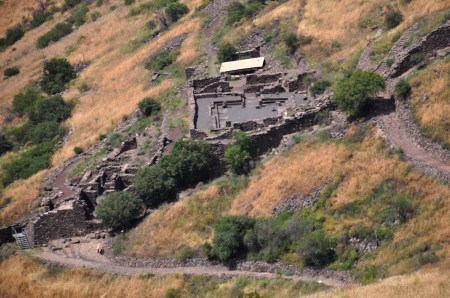Gamla was a Jewish village in the time of Jesus, though not mentioned in the Bible. It was located on the eastern side of the Sea of Galilee, in the southern Golan Heights. Archaeologists have determined that the date of occupation of this settlement goes back to the Early Bronze Age, pre-dating Abraham by some centuries. Our photo here shows Gamla at center. In distance, far right you can see the Sea of Galilee.
Three years before the AD 70 destruction of Jerusalem, Gamla was the site of a grisly battle during the time of the first Jewish Revolt; Gamla fell to the Romans on October 20, AD 67, with Roman forces led by Vespasian (soon to become emperor) and his son Titus (who also succeeded his father as emperor). Josephus gives the number of Jewish casualties at Gamla as totaling 9,000. 4,000 were killed by the Romans, while 5,000 jumped to their death–“while the Romans slew but four thousand, whereas the number of those that had thrown themselves down was found to be five thousand” (Josephus, F., & Whiston, W. (1987). The works of Josephus: complete and unabridged, p. 668).
At center of our photo here you can see the ancient synagogue. Additionally, excavations have uncovered four mikva’ot for the ritual baths.
Gamla was known for its production of olive oil.
Danny Syon gives the following information in Biblical Archaeology Review:
To understand the battle at Gamla, we must first understand the topography that provides its breathtaking setting. Gamla is located on the Golan Heights, on a narrow, pointy spur high above the Sea of Galilee. It is enclosed on all sides by steep ravines, except to the east, where it is connected by a slim saddle to the plateau above. Huge boulders on top of the hill make the spur resemble a gigantic reclining camel with a hump, which doubtless led early settlers in about 150 B.C.E. to name the site Gamla—“camel” in Aramaic.
The early houses of these settlers stood on top of the hill, where the inhabitants could easily look to the east—the only direction from which friend or foe would approach. All other directions were well protected by nature.
It was important for the Romans to destroy Gamla because it was the central Zealot stronghold east of the Sea of Galilee. The Zealots were among the most radical of the Jewish groups supporting the revolt. Moreover, since Gamla was near the main road connecting Israel to the great Jewish centers in Babylon, it was the natural entry point for any help the Zealots hoped for from their brethren in Mesopotamia. For this reason, too, it was important for the Romans to destroy Gamla at the outset.
The Jewish revolt was no small matter for Rome. If the Jews could revolt, the allegiance of no province could be counted on. The Romans sent some of their best legions to Palestine to quell the rebellion. Leading the Roman troops were Vespasian and his son Titus, both of whom would later become emperors—in large part on the basis of their victories over the Jews. The Roman legions landed at the seaport of Acco. Vespasian decided that the best way to break the resistance would be to take the rear first—the Galilee and the Golan—and only then to proceed on to the heart of the rebellion—Judea and its capital, Jerusalem. The Romans marched through the Galilee, systematically taking city after city and village after village, continuing on toward Gamla. . .
Gamla is one of very few places in the Roman empire where a battle site was abandoned and never resettled. This enables us to gather unprecedented information on strategy, tactics and troop deployment, of both Roman and Jewish forces. So far over 1,000 basalt ballista stones and 1,600 iron arrowheads have been found, an incredible number in comparison with other sites. The number of arrowheads is especially surprising because after the battle the Romans would have collected spent arrows for reuse. The concentration of ballista stones and arrowheads was especially great in and around the breach in the wall. Clearly an artillery barrage took place here. (BAR 18:01 Jan/Feb 1992)




Reblogged this on Pilgrim’s Progress revisited – Christiana on the narrow way and commented:
Some crucial history here. Thank you, Leon Mauldin!
LikeLike
Thanks !
LikeLike
Great article Leon Mauldin!
LikeLike
[…] 3. Gamla in the Galilee […]
LikeLike